Hey wine and chocolate lovers! You’ve just bitten into that 85% dark chocolate truffle, paired with a lovely little pinot noir from the Willamette Valley…the chocolate caressing the inside of your mouth, the wine whispering gently…your body and soul wrapped in conjugal bliss around the world’s most toothsome twosome…
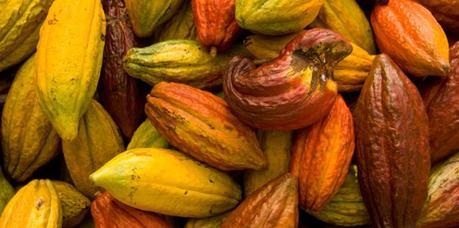
A cocoa pod used to make Amano Chocolate’s award-winning chocolates that pair well with wine. | Image: Courtesy amanochocolate.com
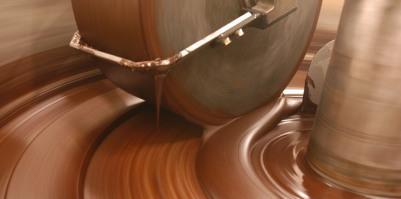
Grinding cocoa used to make Amano Chocolate’s award-winning chocolates that pair well with wine. | Image: Courtesy amanochocolate.com
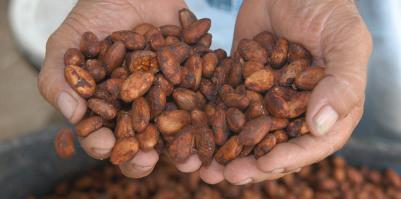
…ever wonder who conjures up all that artisanal chocolate magic? Recently, binNotes caught up with Amano Chocolates founder and Head Chocolatier Art Pollard to talk about love, passion, and the terroir of chocolate. Amano means ‘they love’ and ‘by hand‘ in Italian – a name evocative of award-winning Amano Chocolates‘ love and passion for the careful crafting of artisan chocolate through traditional methods, exacting standards, and exotic sourcing.
Tell readers a little bit about the ‘story’ of Amano Chocolates.
“We launched in 2007 with the single most goal of creating the world’s finest quality chocolate. This is of course, a tall order and somewhat subjective but, I’ve always believed if you are going to do something, do it all the way. It was a long journey prior to launching of course… It took two years to build our factory with lots of experiments to ensure that the finished chocolate wasn’t just good but was exceptional.
Somehow, National Public Radio managed to get samples of our early test batches. Much to our surprise, in February of 2007 they announced that we were one of the best chocolates in the US. We hadn’t launched yet but we looked at each other and said:”I guess we just launched.” We turned on the website and that began an amazing journey.
Since launching, we have won over 150 first place awards through competitions in Europe and the United States. What is more amazing to me however is how what we have done has touched people’s lives both here and in our farmers lives. The joy that I see in their eyes when I take the finished chocolate back to the farmers is truly priceless. As to whether we make the world’s finest quality chocolate, I’ll leave that up to you. It is after all a highly personal question. The world’s finest chocolate truly is the one we love the most.”
As a chocolatier, do you find that the terroir of chocolate ,like wine , informs its flavor profiles?
“Most definitely, the terroir of the cocoa has a huge affect on the finished flavor of the chocolate. At least if the chocolate maker wants it to. Many of the interesting flavors are actually removed by the larger chocolate companies. There are many reasons for this. One of which is consistency. The large chocolate companies want their chocolate to taste the same day in and day out. Hershey’s still tastes like it did 50 years ago or when it first started. (It was made with spoiled milk then and is made with milk that is artificially spoiled now.) I understand and somewhat appreciate why they make these decisions. One of which is they don’t want to be confronted that the chocolate they made last week, last month or last year was better than what they are making today.
In their quest for consistency however, they miss out on the wonderful world of flavor. Cocoa is after all an organic ingredient. It comes from plants, it is made from the soil in which it is grown and is subject to weather and other environmental effects.
To make the chocolate consistent, the beans are roasted way past the point where the interesting and wonderful flavors are. These flavors are literally “burned out” leaving a mass of roasty flavors instead that come primarily from the burned cellulose that has undergone a maillard reaction. The aromatic flavor compounds go literally up the chimney.
However, with good fine quality chocolate such as Amano, these flavors are preserved. Roasting is a process where the natural flavors of the bean are actually enhanced and brought out. Just as spices are enhanced by a light gentle roasting, so too are cocoa beans. Too much however just means the flavors are lost rather than enhanced. “
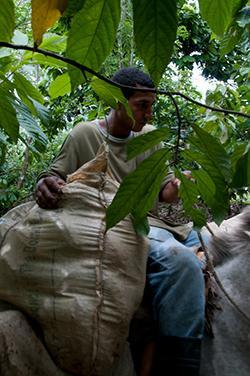
Delivering chocolate from remote regions used to make Amano Chocolate’s award-winning chocolates that pair well with wine. | Image: Courtesy amanochocolate.com
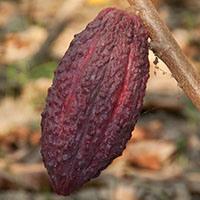
Cocoa-pods used to make Amano Chocolate’s award-winning chocolates that pair well with wine. | Image: Courtesy amanochocolate.com
If terroir indeed informs the flavor profile(s) of chocolate, how does that translate into the chocolate grown and used in Amano Chocolates?
“Each chocolate that we make is completely and totally unique in terms of flavor when compared with the other chocolates we make. We have one made from literally the world’s most highly sought after cocoa, for example, (Chuao) that has a huge number of layers of flavor that keep coming at you in intoxicating waves. Another, our Dos Rios is more straight forward but, tastes like bergamot orange and lavender. (These aren’t flavors we are adding, they are a natural component of the beans.) Both are incredibly delicious but for very different reasons. Another chocolate we have tastes like grapefruit but has this incredibly leatheriness and earthiness to it. Each and every time you taste a chocolate made by Amano, it has its own story not only in terms of where the cocoa comes from but also in terms of flavor. “
Where does Amano source its chocolate?
“We source just about all of our cocoa directly from the farmers who grow the cocoa. This means we often have really incredible relationships with the farmers and their families. The farmers with whom we work live in countries such as : Ecuador, Dominican Republic, Madagascar, Papua New Guinea, and Venezuela. Needless to say, I have quite a few frequent flyer miles at this point.”
You mentioned three (3) basic types of chocolate. What are they, and where are they grown?
“Classically, cocoa is divided up into three groups: Criollo, Trinitario, and Forestero. Criollo has meant cocoa that has a genetic heritage through Venezuela. Forestero comes from the upper Amazon basin. Trinitario is a variety that is actually a hybrid between the two that originates (as the name implies) from Trinidad. These varieties have been transplanted all over the world. However, most of the cocoa out of the Caribbean is Trinitario and most everything out of Africa is Forestero as it is what is preferred by the large chocolate companies due to Forestero’s high disease resistance and productivity. (Flavor is far down on the list of priorities for the industrial chocolate companies. It is far more important for them.)
These terms are often confusing and are used differently by different people for different reasons. Modern genetic research has shown eight distinct genetic groups and it is my belief that many more will be found as genetic research continues. Each variety has its own unique flavor characteristics and each genetic group has many subgroups. Cocoa has never really been bred like other agricultural crops so there are few distinct native varieties like we have with apples. (Though there are clonal groups.) All in all, the mix of genetics and flavors are really exciting. There is the very real possibility that neighboring valleys will produce very different cocoa and finished chocolate. Even more amazing is you can have a similar effect with neighboring farms.
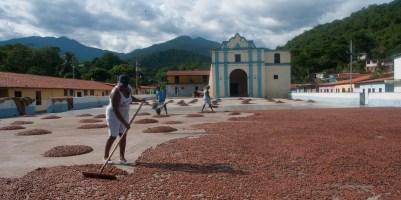
The famous cocoa-drying churchyard of Chuao, Venezuela, one of Amano Chocolate’s sources for their award-winning chocolates that pair well with wine. | Image: Courtesy amanochocolate.com

Amano founder and head Chocolatier Art Pollard at the winnowing machine used to hand-craft their award-winning chocolates that pair well with wine. | Image: Courtesy amanochocolate.com
Can you take readers through the basic process in making an Amano Chocolate bar?
“Wow, that is huge… The amount of work that goes into making chocolate is far more than anyone ever expects. But, here is the ‘short’ rundown:
- The trees are highly disease susceptible. Thus the farmers have to put a lot more work into their cocoa trees than other crops. So, as you can imagine, it all starts with a farmer who cares for their trees.
- Each pod must be hand cut from the tree. (Not picked but hand cut so as to not hurt the tree.) Each pod equates to approximately one chocolate bar.
- The pods are split open by a machette one by one and the beans removed and then pulled from the central stock they grow on.
- For 37 days the beans are fermented in giant wooden boxes. Each day they must be taken out and turned over and put back in. That’s a lot of work.
- The cocoa is dried. This takes 57 days. The cocoa is put out in the morning and brought back in in the evening. Some farmers turn it over every hour.
- The cocoa is then put into bags and shipped to us.
- We hand sort the cocoa to remove any sticks, stones, and other items that aren’t supposed to be there.
- The beans are hand roasted in our antique cocoa roaster.
- The beans are dumped onto a cooling table that cools the beans and stops the roasting process.
- The shells are removed in our winnowing machine. (All built of mahogany and maple.)
- The bits of bean (now called nibs) are stone ground into a paste.
- Sugar is added.
- The cocoa (now like bread dough) is fed through a refiner that makes this smooth. This is all done with buckets and by hand so it is a lot of work.
- The chocolate is put in the conche. We have a complicated conching process. The difference between not enough conching and too much is about 30 seconds.
- The chocolate is unloaded and it is filtered and run past magnets to ensure it is safe.
- The chocolate goes into our cool room to harden into 50 lb.blocks.
- When it is time to mold, the chocolate is remelted.
- The chocolate is tempered so it will crystalize properly. This is a heating and cooling process and can be quite tricky.
- The chocolate is then fed into a molding machine that injects the chocolate into molds.
- The chocolate cools and hardens.
- All the bars are hand wrapped and put into boxes.
Yep, it is a huge amount of work.”
Anything else you care to share about Amano Chocolates with readers?
“I love what I do. Each of us is completely absorbed and passionate about what we do.”
Finally, here’s a question I ask all the winemakers I interview, and it seems appropriate to ask you as a chocolatier: “If making chocolate has taught me anything, it’s taught me…?”
“Each and every step is the most important step.”

